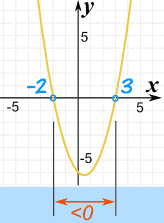Topic : Linear inequalities
• In mathematics a linear inequality is an inequality which involves a linear function. A linear inequality contains one of the symbols of inequality:
• < is less than
• > is greater than
• ≤ is less than or equal to
• ≥ is greater than or equal to
• ≠ is not equal to
• A linear inequality looks exactly like a linear equation, with the inequality sign replacing the equality sign.



Example 1
|
Solve and graph the solution set of: 2x - 6 < 2
| Add 6 to both sides. 2x-6 < 2 Divide both sides by 2. 2x < 8 Open circle at 4 x < 4 (since x can x < not equal 4) and an arrow to the left (because we want valuesless than 4). |
Example 2
|
Solve and graph the solution set of:
5 - 3x  13 + x
13 + x
| Subtract 5 from both sides. Subtract x from both sides. Divide both sides by -4, and don't forget tochange the direction of the inequality ! (We divided by a negative.) |
5 - 3x
-3x -4x x |
| Closed circle at -2 (since x can equal -2) and an arrow to the right (because we want values largerthan -2). |
Example 3
|
Solve and graph the solution set of:
3(2x + 4) > 4x + 10
| Multiply out the parentheses Subtract 4x from both sides. Subtract 12 from both sides. Divide both sides by 2, but don't change the direction of the inequality, since we didn't divide by a negative. | 3(2x + 4) > 4x + 10 6x + 12 > 4x + 10 2x + 12 > 10 2x > -2 x > -1 |
| Open circle at -1 (since x can not equal -1) and an arrow to the right (because we want values largerthan -1). |



And here is the plot of x2 − x − 6:
|  |











No comments:
Post a Comment